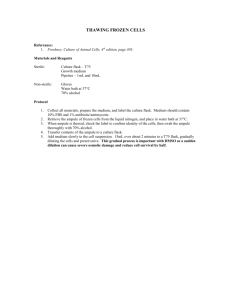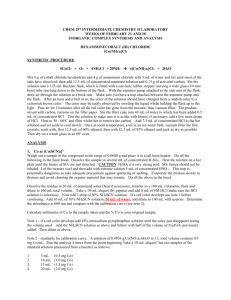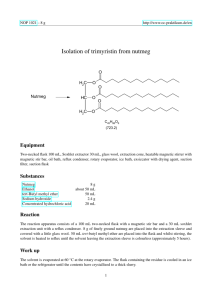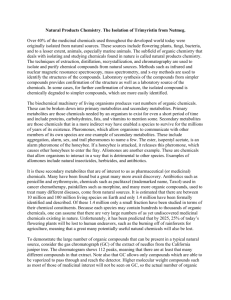Isolation of Trimyristin from Nutmeg and Its Hydrolysis to Myristic
advertisement
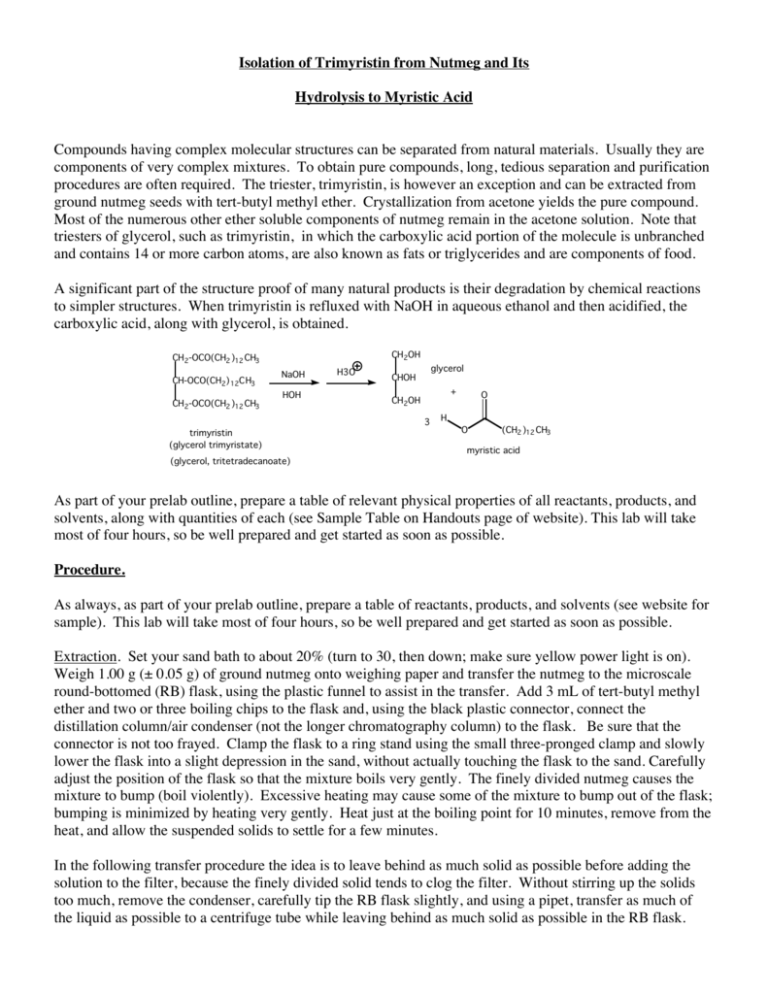
Isolation of Trimyristin from Nutmeg and Its Hydrolysis to Myristic Acid Compounds having complex molecular structures can be separated from natural materials. Usually they are components of very complex mixtures. To obtain pure compounds, long, tedious separation and purification procedures are often required. The triester, trimyristin, is however an exception and can be extracted from ground nutmeg seeds with tert-butyl methyl ether. Crystallization from acetone yields the pure compound. Most of the numerous other ether soluble components of nutmeg remain in the acetone solution. Note that triesters of glycerol, such as trimyristin, in which the carboxylic acid portion of the molecule is unbranched and contains 14 or more carbon atoms, are also known as fats or triglycerides and are components of food. A significant part of the structure proof of many natural products is their degradation by chemical reactions to simpler structures. When trimyristin is refluxed with NaOH in aqueous ethanol and then acidified, the carboxylic acid, along with glycerol, is obtained. CH 2OH CH 2-OCO(CH2 )12 CH3 CH-OCO(CH2) 12CH3 CH 2-OCO(CH2 )12 CH3 NaOH HOH trimyristin (glycerol trimyristate) (glycerol, tritetradecanoate) H3O glycerol CHOH + CH 2OH 3 O H O (CH2 )12 CH3 myristic acid As part of your prelab outline, prepare a table of relevant physical properties of all reactants, products, and solvents, along with quantities of each (see Sample Table on Handouts page of website). This lab will take most of four hours, so be well prepared and get started as soon as possible. Procedure. As always, as part of your prelab outline, prepare a table of reactants, products, and solvents (see website for sample). This lab will take most of four hours, so be well prepared and get started as soon as possible. Extraction. Set your sand bath to about 20% (turn to 30, then down; make sure yellow power light is on). Weigh 1.00 g (± 0.05 g) of ground nutmeg onto weighing paper and transfer the nutmeg to the microscale round-bottomed (RB) flask, using the plastic funnel to assist in the transfer. Add 3 mL of tert-butyl methyl ether and two or three boiling chips to the flask and, using the black plastic connector, connect the distillation column/air condenser (not the longer chromatography column) to the flask. Be sure that the connector is not too frayed. Clamp the flask to a ring stand using the small three-pronged clamp and slowly lower the flask into a slight depression in the sand, without actually touching the flask to the sand. Carefully adjust the position of the flask so that the mixture boils very gently. The finely divided nutmeg causes the mixture to bump (boil violently). Excessive heating may cause some of the mixture to bump out of the flask; bumping is minimized by heating very gently. Heat just at the boiling point for 10 minutes, remove from the heat, and allow the suspended solids to settle for a few minutes. In the following transfer procedure the idea is to leave behind as much solid as possible before adding the solution to the filter, because the finely divided solid tends to clog the filter. Without stirring up the solids too much, remove the condenser, carefully tip the RB flask slightly, and using a pipet, transfer as much of the liquid as possible to a centrifuge tube while leaving behind as much solid as possible in the RB flask. Allow the solids to settle in the centrifuge tube for a minute. Then again, while leaving behind as much solid as possible, transfer as much liquid as possible into a pressure filtration assembly (p. 68 lab text) and filter the liquid into a clean, dry, tared 25 mL Erlenmeyer flask (tared = weighed empty). Be sure that the filter assembly is resting in the flask prior to transferring the liquid, as some liquid will filter through immediately. The filtration apparatus is made by pushing the micro Buchner funnel (polyethylene frit in place - no filter paper) into the end of a plastic pipet which has had the tip cut off and which has had a small hole cut into the squeeze bulb). Allow most of the liquid to filter by gravity, then, while holding your thumb over the hole in the squeeze bulb, gently apply pressure to complete the filtration. Care must be taken when squeezing the pipet bulb on the filter pipet. Too much pressure might cause the filter to leak or fall off. Add about 2 mL of fresh tert-butyl methyl ether to the solid in the RB flask, warm briefly, let the solids settle for a minute, and pipet the liquid to the centrifuge tube as before. Again allow the solids to settle briefly in the centrifuge tube, then filter the liquid through the pressure filtration apparatus, into the same 25 mL Erlenmeyer flask. Doing a rinse such as this helps to ensure that any trimyristin that was left behind in the RB flask and centrifuge tube is not lost, thereby helping to ensure that the yield of trimyristin is maximized. In the fume hood, carefully pass a gentle stream of air over the solution while warming the flask with your hand until all of the solvent has evaporated and a yellowish solid remains. Be careful to not lose material by spattering the solution with too fast an air flow. After most of the solvent has evaporated, a gummy yellowish solid will remain. This is the crude trimyristin. Residual solvent may take some time to completely evaporate, but the next step may be started even if the solid is not completely dry. At this point raise the setting on the sand bath to about 30 so the bath will be hot enough for the hydrolysis below. Recrystallization of trimyristin. After allowing the crude trimyristin to air dry for another 5 min, obtain its weight. Note that this is an approximate weight because the material is not yet completely dry. To the solid in the 25 mL Erlenmeyer flask, add 1 mL acetone per 50 mg crude material, warm on the sand bath to dissolve the solid (caution: acetone has a low BP so heat carefully or material will be lost), allow the solution to cool slowly to room temperature (about 5 min). If crystals do not appear after cooling, scratch the inside surface of the flask with a glass stirring rod at the air-liquid interface to induce crystallization. (If crystals do not form at this point continue anyway.) Cool the solution in an ice-water bath. If crystals have not yet formed, scratch the surface of the flask with a glass stirring rod at the air-liquid interface. Allow the solution to cool in the ice-water bath for 15 min. Collect the crystals by vacuum filtration on a small Hirsch funnel (always clamp the filter flask to prevent it from tipping over). Rinse the crystals in the following way: lift the funnel slightly to break the vacuum, cover the crystals with about 1 mL of ice-cold acetone, and immediately reapply the vacuum. Allow air to pass over the crystals for a few minutes then scrape the crystals onto a tared piece of 9 cm filter paper and allow the crystals to dry to constant weight. Save a small sample for a MP. Hydrolysis. Weigh 60 mg (± 5 mg but weigh exactly) of the trimyristin onto a tared piece of weighing paper and transfer it to a clean RB flask (use a funnel). Add 2 mL of 6 M NaOH, 2 mL of 95% ethanol, and a boiling chip and reflux the solution gently on the sand bath for 45 minutes. If less than 60 mg of trimyristin was obtained, scale the hydrolysis down by a factor of 2 (halve the amounts of all reactants – trimyristin, NaOH, and ethanol - but keep the reaction time the same). Overheating will cause ethanol to evaporate. Note the approximate level of liquid in the flask and if necessary, replace any ethanol that is lost to evaporation. During the hydrolysis period, recrystallize the remaining trimyristin a second time, this time allowing the warm solution to cool to room temperature for 10 min before cooling in ice for another 10 min. In this second recrystallization dissolve the trimyristin in the minimum amount of acetone at the BP of the solution. Collect product by vacuum filtration and allow it to dry to constant weight. Compare the MPs of the once recrystallized and the twice recrystallized trimyristin. After the hydrolysis has proceeded for 45 minutes, allow the flask to cool to RT and pour the contents into a 50 mL beaker containing 8 mL of water. Carefully, in the hood, add dropwise with stirring, 2 mL of concentrated HCl (caution: corrosive liquid/noxious vapors). Myristic acid should precipitate. Cool the beaker in ice water for 10 min, with stirring, and collect the solid by vacuum filtration on a small Hirsch funnel. Rinse with three small portions of water, by breaking the vacuum, adding just enough water to cover the solid, and reapplying the vacuum as before. Filtration of the fine crystals is slow. Using too much rinse water will slow the process considerably. Allow the solid to dry at least overnight, weigh it, take a MP, and calculate the % yield. WASTE: Place all liquid wastes into the "Organic Liquid Waste" container. BEFORE YOU LEAVE THE LAB: turn off the sand bath, Mel-Temp, air and vacuum, put away your equipment and lock your drawer, clean up your work areas, close the fume hood sash completely and ask your TA for her or his signature. If you see caps off of bottles, replace the caps. If you see spilled chemicals, clean them up or at least report it to your TA. Summary of Results. Record the weight of trimyristin at all stages of the experiment. Report the following: (1), % recovery of crude and once recrystallized trimyristin from nutmeg (e.g., extracting 1.02 g of ground nutmeg seed resulted in a 70 % yield of crude trimyristin and, after the first recrystallization, a 50 % recovery was obtained, based on the original amount of nutmeg); (2), % recovery in the second recrystallization; (3), % yield of myristic acid obtained in the hydrolysis; (4), the MPs of once recystallized and twice recrystallized trimyristin, and myristic acid. Postlab Questions 1.) What is the structural difference between saturated, monounsaturated, and polyunsaturated fats? Of which kind is trimyristin? 2.) In the first recrystallization, after the solid has been dissolved in warm acetone, the solution is allowed to cool slowly to room temperature. In an older procedure the warm solution was placed directly into an ice bath. How does this older procedure differ from a normal recrystallization and what might be the consequences? 3.) One triglyceride present in animal fats is tristearin (glycerol trioctadecanoate). What is the theoretical yield, in grams, of stearic acid upon hydrolysis of 1.8 g of tristearin? (See an Organic text, CRC Handbook, or ChemFinder.com for structure and MW.) 4.) In the hydrolysis of trimyristin the reaction mixture is heated at about 75° for 45 minutes. What is the purpose of heating a reaction mixture? 5.) If the mixture were heated at 40° for 45 minutes, what would be the result? (revised, pws, 10/10)



